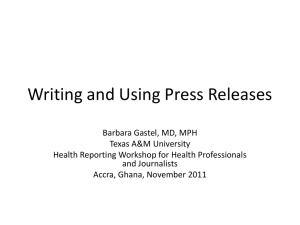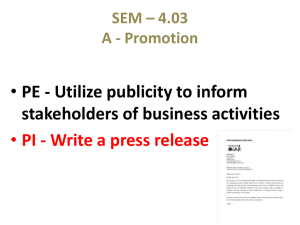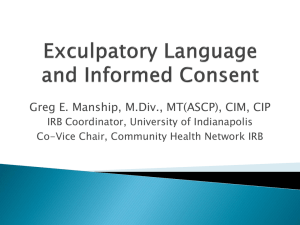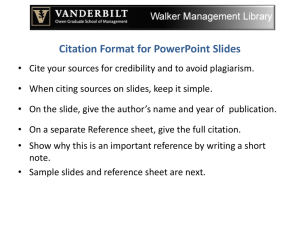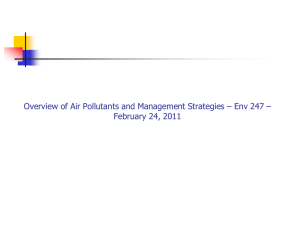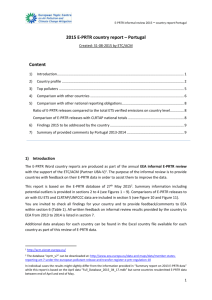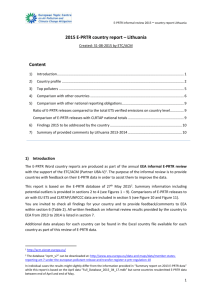PRTR workshop ( Feb 2013 ) - Presentation
advertisement
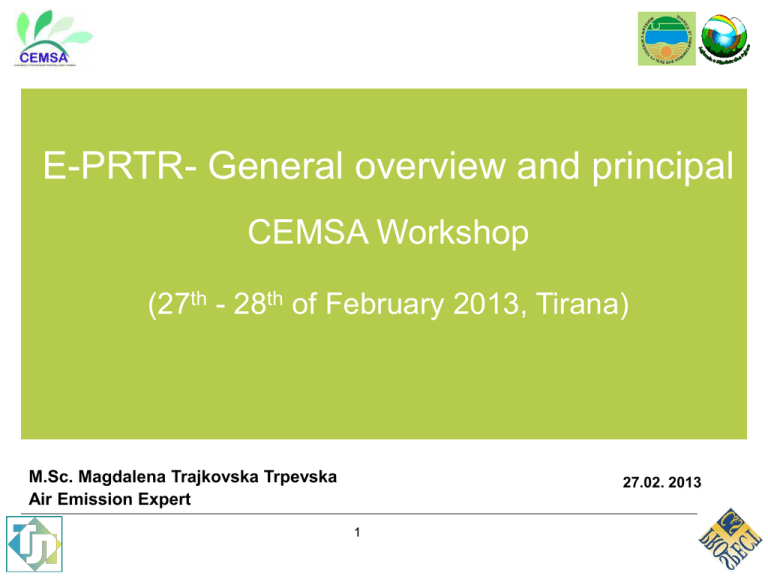
E-PRTR- General overview and principal CEMSA Workshop (27th - 28th of February 2013, Tirana) M.Sc. Magdalena Trajkovska Trpevska Air Emission Expert 27.02. 2013 1 What is a PRTR? (PRTR) is a national or regional environmental database or inventory of potentially hazardous chemical substances and/or pollutants released to air, water and soil and transferred off-site for treatment or disposal. The industrial or business facilities quantify and report the amounts of substances released to each environmental medium (air, water, soil) or transferred off-site for waste management or wastewater treatment. 2 Why a PRTR ? - Purpose PRTRs provide public access to data via the Internet, CD-ROMs, publications and annual reports. PRTR also includes pollution diffuse sources of pollution (such agriculture and transport) Data compiled by environmental authorities PRTR data may be presented geographically, by industry sector, by facility … 3 The EU and the PRTR Protocol European Union (EU) legislation Regulation (EC) 166/2006 Establishes the European PRTR Based on a previous register (EPER) and IPPC Directive 32 countries: – 27 EU Member States, Iceland, Liechtenstein, Norway – Switzerland and Serbia (voluntary) Annual reporting Data available as of 2007 (first published in 2009) Implements the PRTR Protocol + beyond 91 pollutants (Hexabromobiphenyl, Octylphenols, Fluoranthene, Isodrin, Benzo(g,h,i)perylene + 86 of the PRTR Protocol) 4 What are the benefits of developing a PRTR ? A PRTR can include information on: Who is generating potentially harmful releases or transfers of waste to various environmental media; What pollutants are being released or transferred; How much is being released or transferred over a specific time period; What is the geographic distribution of pollutant releases or transfers. 5 What are the benefits of developing a PRTR ? Benefits for governments Benefits for industry Major driving force for pollution reduction throughout many sectors of the economy. Dissemination of PRTR data enables similar industries to benchmark their environmental performance with other companies in the sector and to reduce releases and thereby saving money. PRTR data can be used in land-use planning and in licensing decisions for new plants and facilities. PRTRs provide information on releases of hazardous substances and pollutants that can encourage industry, business and the community to reduce releases and transfers of waste and to adopt cleaner production techniques. 6 What are the benefits of developing a PRTR ? Benefits for other parties Stimulate interested or potentially affected parties to ask questions of and to seek improvements to human health and environmental well-being. Non-governmental organizations can both use and disseminate PRTR data to reflect their individual purposes and goals, as well as those of their constituencies. Researchers and academics can use PRTR data for modeling or other studies, and the financial sector for evaluating investment proposals or for considering insurance or sustainability issues. Better informed about the environmental performance of individual facilities, economic sectors and government regulatory agencies. 7 Who reports? Mandatory annual reporting is required with respect to a wide range of activities: • Refineries, thermal power stations, the chemical and mining industries, waste incinerators, waste water treatment facilities, wood and paper production and processing, shipbuilding, animal and vegetable production and intensive agriculture and aquaculture, among others, where these activities are carried out on a significant scale. • Diffuse sources, such as transport, agriculture, and domestic heating, for which emissions cannot be measured at specific points. 8 Thresholds? E-PRTR As with the pollutant thresholds, there are two types of activity threshold. • One type of activity threshold is based on the capacity of the facility, e.g., the number of megawatts, tons of material processed per hour and so on. → Country applying a pollutant threshold based on the quantity of the pollutant released or transferred should generally apply an activity threshold based on the capacity of the facility, • The second is based on the number of employees, with 10 or more employees relevant to the requirement of the report. → Whereas a Country decide for a pollutant threshold based on the quantity of the pollutant manufactured, processed or used should generally apply an activity threshold based on the number of employees 9 To whom is the data reported? E-PRTR Obligation to report data to EU National PRTR = national choice Designate a competent authority or authorities to manage the national PRTR It should establish a national legal framework which defines the obligations of the administrative authorities who will be collecting, validating and managing the register 10 Collecting the data? The most common structures in use for collecting the data needed to establish national emissions registers are: information requirements set out in environmental permits essential self-monitoring and reporting calculation/estimation 11 What uses can be made of PRTR information? PRTRs are primarily intended to serve the general public, but they also assist Governments in tracking pollution trends, setting priorities and monitoring compliance with international commitments PRTR can benefit industry, both management and workers, through stimulating improved environmental management Users of PRTRs The general public and citizens’ organizations interested in obtaining information on local, regional or national pollution. The media 12 What uses can be made of PRTR information? PRTRs can be a valuable tool for environmental education Environmental authorities can use PRTRs to review both the compliance of local facilities with their permit conditions and national progress towards international commitments. For facilities, the exercise of monitoring or estimating pollution levels, as well as their mandatory publication, can encourage efforts to improve efficiency and reduce pollution levels. 13 Data flow 14 Coverage Coverage 65 industrial activities 91 pollutants 65 activities in 9 sectors: 91 pollutants in 7 groups: Energy Production and processing of metals Mineral industry Chemical industry Waste and waste water management Paper and wood production and processing Intensive livestock production and Aquaculture Animal and vegetable products from the food and beverage sector Other activities. 15 Greenhouse gases Other gases Heavy metals Pesticides Chlorinated organic substances Other organic substance Inorganic substances Point source DATA FLOW Facility Release/transfer report … … … Competent authority Validation … Country Compilation of reports Europe Compilation for EU Publication of E-PRTR Public (http://prtr.ec.europa.eu/) 16 … The relation to the IPPC Directive The Protocol includes the activities set out in Annex I of the IPPC Directive (which is identical to Annex A3 of the EPER Decision). However, the Protocol and Annex I of the E-PRTR Regulation contain several changes and additional activities compared to Annex I of the IPPC Directive. For further details, see Appendix 2 to this guide: Comparison of IPPC and E-PRTR activities 17 What and how to report? Reported releases and off-site transfers are totals of releases and offsite transfers from all expected, accidental, routine and non-routine activities at the site of the facility Accidental releases are all releases which are not expected, routine or non-routine, and result from uncontrolled developments in the course of the operation of Annex I activities on the site of the facility Non-routine activities are extraordinary activities that are carried out under controlled operation of Annex I activities and that may lead to increased releases of pollutants; for example shut-down and start-up processes before and after maintenance operations The releases to air, water and land shall include all releases from all sources included in Annex I to the E-PRTR Regulation at the site of the facility, although there are special considerations for land releases 18 What and how to report? If the sum of releases to one medium (air, water or land) of a pollutant from all Annex I activities at a facility exceeds the corresponding release threshold values for that medium, the release has to be reported Consideration should be given to all Annex II pollutants that are relevant to the processes operated at that facility and that might therefore occur in the facility’s releases and off-site transfers of waste water. This consideration is not limited to those pollutants that are listed in the facility’s permit. Appendix 4 and 5 E-PRTR Guidance document 19 What and how to report? Important to note!!! (1) Where a facility that performs an E-PRTR-relevant activity releases additional pollutants (exceeding the relevant threshold value) not specified for that activity in the tables, but contained in Annex II to the E-PRTR Regulation, the pollutants have to be reported. Reporting by the operator of a facility will in most cases contain less pollutants than listed in the tables of Appendix 4 or 5. In practice, the Annex II pollutants that are relevant for reporting purposes will be decided for each facility on a case-by-case basis. 20 What and how to report? Important to note!!!(2) In most cases additional checks will be sufficient to determine whether a certain pollutant is released above the threshold value; In case of doubt, a representative measurement might result in more certainty on complete reporting. If concentrations in releases are below determination (quantification) limits this does not always permit the conclusion that threshold values are not exceeded 21 What and how to report? Important to note!!!(3) Releases and off-site transfers originating from remediation measures (for example decontamination of polluted soil or groundwater) on the site of the facility shall be reported if the original contamination is related to an ongoing Annex I activity. Releases and off-site transfers of waste water have to be reported in terms of the quantity of pollutants released in kg/year. Off-site transfers of waste have to be reported in terms of waste quantities transferred off-site in tones/year. The type of waste (hazardous, non-hazardous) and the intended waste treatment (recovery, disposal) have to be reported. For transboundary transfer of hazardous waste, the waste destination (name and address of recovered/disposer and the address of the actual site of recovery/disposal) are required. 22 What and how to report? Important to note!!!(4) Operators are obliged to specify any data that relate to accidental releases where such information is available if the total of all (expected, accidental, routine and non-routine) releases exceeds the respective threshold values. Estimation is particularly relevant when reporting on accidental releases, as data on such releases are not necessarily immediately available to the operator. The quantity of accidental releases has to be included in the total quantity of releases (example: accidental release = 1 kg/y; expected, routine and non-routine release = 10 kg/y; total release = 11 kg/y). Usually it is possible to quantify accidental releases. Quantification might, for example, be possible on the basis of determination of residual quantities in tubes or tanks or by considering the duration of an accidental release and relating this to assumed flow rates. In particular cases it might, however, be impossible to derive data based on estimations for all relevant pollutants particularly when accidental releases to air are involved. To reduce duplicate reporting, pollutant release and transfer register systems may, under the Protocol, be integrated to the degree practicable with existing information sources such as reporting mechanisms under licenses or operating permits. 23 What and how to report? Non-hazardous waste (within the country or transboundary) Hazardous. waste (within the country) Identification of the facility air water Facility Hazardous waste (transboundary) 1) which is subject to disposal operations “land treatment” or ”deep injection”, shall be reported as release to land by the operator of the facility originating the waste 1) Waste 24 land Off-site Waste-Water Treatment Plant What and how to report? Table : Specification of the reporting requirements for releases and off site transfers Quantity 1 M/C/E 3 Method used 4 to air kg/year 2 X X to water kg/year 2 X X to land kg/year 2 X X Off site transfers of: Quantity 1 M/C/E 3 Method used 4 Pollutants wastewater kg/year 2 X x for disposal (D) t/year x x for recovery (R) t/year x x for disposal (D) t/year x x for recovery (R) t/year x x for recovery (R) t/year x for disposal (D t/year x in Name and address of recoverer/ disposer Address of actual recovery/disposal site receiving the transfer x x x x x x 5 Non-hazardous waste Hazardous waste within the country Hazardous waste transboundary 25 Data management OPERATORS OF FACILITIES have to report all required information to the competent authorities. Before submitting the data to the relevant competent authority, the operator should ensure an appropriate quality of the data by ensuring that the information is complete, consistent and credible. If an operator of a facility has justifiable reasons that specific information concerning releases or off-site transfers should be kept confidential, he has to inform the competent authorities. 26 Data management and reporting under E-PRTR CEMSA Workshop (27th - 28th of February 2013, Tirana) M.Sc. Magdalena Trajkovska Trpevska Air Emission Expert 27.02. 2013 27 Data collection and reporting process EPER Reporting process Identify facilities Determine pollutant emissions Report according to formats Review report Collect data Validate data 28 Disseminate results Identification of facility Table :Explanations related to information required for the identification of the facility 29 Identification of facility Facility operators may provide optional information on the facility. There is no obligation to report it but the information may be of interest to the public and may also be useful for the competent authority for assessing the quality of the data. Table 3 gives an overview of this optional information according to Annex III to the E-PRTR Regulation: Optional information Production volume Number of installations Number of operating hours in year Number of employees Text field for textual information[1] or website address delivered by facility or parent company [1] Textual information should be provided in mother tongue and optionally in English language 30 Coding of activities In addition to the information required for the identification of the facility, all Annex I activities carried out at a facility have to be listed according to the coding system given in Annex I and, (if available), the IPPC code . In accordance with Annex I to the E-PRTR Regulation, the E-PRTR code consists of a number from 1 and 9 and a letter from a to g. For some activities, there is a further sub-division from (i) to (xi). This subdivision has not to be reported. 31 Coding of activities Example: Structure for reporting of all Annex I activities of a facility (with examples) Annex activity* I E-PRTR code IPPC code[1] Activity name according to Annex I of E-PRTR Regulation (declaration not obligatory) 1** 2.(f) 2.6 Installations for surface treatment of metals and plastic materials using an electrolytic or chemical process where the volume of the treatment vats equals 30 m3 2 9.(c) 6.7. Installations for the surface treatment of substances, objects or products using organic solvents, in particular for dressing, printing, coating, degreasing, waterproofing, sizing, painting, cleaning or impregnating with a consumption capacity of 150 kg per hour or 200 tonnes per year N … … … * Consecutive no. of Annex I activities ** Activity 1 shall be the main Annex I activity [1] The IPPC-code consists of a two digit code 32in accordance with Annex I of the IPPC-Directive Identification of the main activity All releases and off-site transfers of the facility are attributed to the main Annex I activity. Often the main Annex I activity is similar to the main economic activity of the facility. When the main economic activity is not representative of the processes undertaken at the facility, the main Annex I activity could be associated with the most polluting activity of the facility. All releases and off-site transfers of the facility are attributed in further aggregations of the data to the main Annex I activity given by the operator. ANNEX I E-PRTR 33 Releases to air, water and land Operators shall report releases to air, water and land of any pollutant specified in Annex II to the E-PRTR Regulation for which the applicable threshold value specified in Annex II is exceeded. All release data have to be expressed in kg/year and with three significant digits. The rounding to three significant digits does not refer to the statistical or scientific uncertainty, but reflects only the accuracy of the reported data as is shown in the following examples. Table: Examples demonstrating the rounding to three significant digits Original result of determination 0.0123456 kg/year 1.54789 kg/year 7,071.567 kg/year 123.45 kg/year 10,009 kg/year the release Result to be reported (in three significant digits) 0.0123 kg/year 1.55 kg/year 7,070 kg/year 123 kg/year 10,000 kg/year 34 Releases to air, water and land For reporting, the original measured, calculated or estimated value of a release is relevant. The pollutant still has to be reported, even if the value of the pollutant is equal to the threshold value after rounding to three significant digits. The reported release data must include a reference (M, C, E) to the determination methodology used for the reported release data. Where data are measured or calculated ("M" or "C"), the method of measurement and/or the method for calculation shall be indicated 35 Releases to air According to column 1a of the table in Annex II to the E-PRTR Regulation, a total of 60 pollutants are specified as relevant air pollutants. Releases from a facility of air pollutants in excess of the threshold values in column 1a must be reported. This is the case in respect of all 60 air pollutants. Appendix 4 to this guide contains an indicative sector specific sub-list of air pollutants. The list shows for all Annex I activities those air pollutants that are likely to be emitted and aids the identification of relevant pollutants at a given facility. Appendix 3 from the Guidance lists standardized internationally approved measurement methodologies for air and water pollutants. In the case of data indicated as being based on measurement or calculation, the analytical method and / or the method of calculation shall be reported. 36 Releases to air Operators are obliged to specify any data that relate to accidental releases whenever such data is available. Reporting should be done in accordance with Annex III of the E-PRTR Regulation, for example as shown in Table: Releases to air Pollutant no. A Name2 II1 1 Methane (CH4) 3 Carbon dioxide (CO2) 21 Mercury Method M/C/E3 Method used4 C M M IPCC ISO 12039:2001 EN 13211:2001 Quantity T (total)5 (kg/year) 521,000 413,000,000 17.0 Appendix 4 from the E-PRTR Guidance 37 A (accidental)6 kg/year 2.00 Releases to water Reporting should be done in accordance with Annex III to the E-PRTR Regulation, in other words, in an analogous way to that described above in respect of releases to air. Table :Reporting of releases to water (exemplary data) Releases to water Pollutant Method no. A II Name M/C/E 63 Brominated diphenylethers (PBDE) E 76 Total organic (TOC) M carbon Quantity Method used EN 1484:1997 38 T (total) kg/year A (accidental) kg/year 25.5 20.0 304,000 - Releases to land Reporting should be carried out in accordance with Annex III to the E-PRTR Regulation, in an analogous way to that described above in respect of releases to air and water. Table: Reporting of releases to land (exemplary data): Releases to land Pollutant no. II A Method Quantity Name M/C/E Method used T (total) kg/year A (accidental) kg/year 24 Zinc and compounds (as Zn) M EN ISO 11885:1997 125 - 79 Chloride (as total Cl) M EN ISO 10304-1 2,850,000 - n 39 Off-site transfers of pollutants in waste water Off-site transfers of pollutants in waste water Pollutant Method Quantity no. A II Name M/C/E Method used T (total) kg/year A (accidental) kg/year 12 Total nitrogen M EN 12260 76,400,000 - 13 Total phosphorus M EN ISO 6878:2004 10,900,000 - n 40 Off-site transfers of waste Table 1 show how data on off-site transfers of hazardous waste should be reported. Table 2 shows how off-site transfers of non-hazardous waste should be reported. Table 1 Quantity (t/year) Waste treatment operation M/C/E Method used 5 R M weighing 1 D M weighing Off-site transfer of HW within country the Table 2 Off-site transfer of non-haz. Waste Quantity (t/year) Waste treatment operation M/C/E Method used Within the country or to other countries 1,000 R M weighing 10,000 D M weighing 41 Measurement/calculation/estimation of releases and off-site transfers Reporting shall be carried out based on measurement, calculation or estimation of releases and off-site transfers. For the indication of whether the reported release and transfer data is based on measurement, calculation or estimation a simplified system with three classes identified with a letter code is required, referring to the methodology used to determine the data (Class M, Class C, Class E): Class M: Release data are based on measurements (“M”). For these calculations the results of flow determinations are needed. “M” should also be used when the annual releases are determined based on the results of short term and spot measurements. “M” is used when the releases of a facility are derived from direct monitoring results for specific processes at the facility, based on actual continuous or discontinuous measurements of pollutant concentrations for a given release route. 42 Measurement/calculation/estimation of releases and off-site transfers Class C: Release data are based on calculations (“C”). “C” is used when the releases are based on calculations using activity data (fuel used, production rate, etc.) and emission factors or mass balances. In some cases more complicated calculation methods can be applied, using variables like temperature, global radiance etc. Class E: Release data are based on non-standardized estimations (“E”). “E” is used when the releases are determined by best assumptions or expert guesses that are not based on publicly available references or in case of absence of recognized emission estimation methodologies or good practice guidelines. Where the total release of a pollutant at a facility is determined by more than one determination method (e.g. M and C), the determination method with the highest amount of release is chosen for reporting. Example: The release of an air pollutant at a PRTR relevant facility occurs at two stacks (stack A and stack B). The total release exceeds the relevant release threshold. The release at stack A is measured and amounts 100 kg/year. The release at stack B is calculated and amounts 50 kg/year. Since the highest amount of release (100 kg/year) is measured, the total release (150 kg/year) has to be indicated as being 43 based on measurement (M). Reporting Reporting by Operators 1. In the case of data indicated as being based on measurement or calculation the analytical method and/or the method of calculation shall be reported. 2. The operator of each facility shall collect with appropriate frequency the information needed to determine which of the facility’s releases and off-site transfers are subject to reporting requirements under paragraph 1. 3. When preparing the report, the operator concerned shall use the best available information, which may include monitoring data, emission factors, mass balance equations, indirect monitoring or other calculations, engineering judgments and other methods in line with Article 9(1) and in accordance with internationally approved methodologies, where these are available. 44 Reporting Releases and off-site transfers of pollutants in waste water have to be reported as annual quantities of pollutants released in kg/year whereas waste transferred off-site has to be reported in tonnes/year. The annual quantities should be determined with a frequency and duration of data collection sufficient over the year to give reasonably representative and comparable data. When determining the frequency, it is important to balance the requirements with emission characteristics, risk to the environment, practicalities of sampling and the costs. Good practice also suggests matching the monitoring frequency to the timeframes over which harmful effects or potentially harmful trends occur. For more information see the BREF document on General Principles for Monitoring 45 Reporting Operators are obliged to collect the data needed in order to determine which releases and off-site transfers have to be reported. Reporting shall be based on the best available information which enables appropriate quality assurance and which is in accordance with internationally approved methodologies where such methodologies are available. To reduce duplicate reporting (determination of pollutants), the reporting under the European PRTR for a facility may be integrated to the degree practicable and under consideration of the future comparability of the reported data with existing measurement, calculation or estimation methodologies already prescribed for the facility concerned by the competent authorities. The operator of the facility has to decide before collecting the data which determination methodology (M, C or E) for a certain pollutant results in "best available information" for the reporting. Where data are measured or calculated, the method of measurement and/or the method for calculation shall in addition be indicated. 46 Methodologies Operators should prepare their data collection in accordance with INTERNATIONALLY APPROVED METHODOLOGIES ,where such methodologies are available. The following methodologies are considered as internationally approved: CEN and ISO standards as measurement methodologies ; the “Guidelines for the monitoring and reporting of greenhouse gas emissions under the Emission Trading Scheme”, the “IPCC Guidelines” and the “UNECE/EMEP Atmospheric Emission Inventory Guidebook” as calculation methodologies. 47 Methodologies The operator may use "EQUIVALENT" METHODOLOGIES other than internationally approved methodologies, even when available, if one or more of the following conditions are fulfilled: 1. The operator uses one or more measurement, calculation or estimation methodologies already prescribed by the competent authority in a licence or an operating permit for that facility (method name to be reported : PER) 2. A national or regional binding measurement, calculation or estimation methodology is prescribed by legal act for the pollutant and facility concerned (method name to be reported: NRB). 3. The operator has shown that the alternative measurement methodology used is equivalent to existing CEN/ISO measurement standards (method name to be reported: ALT). 4. The operator uses an equivalent methodology and demonstrated its performance equivalence by means of Certified Reference Materials (CRMs) according to ISO 17025 and ISO Guide 33 together with an acceptance by the competent authority (method name to be reported: CRM). 48 Methodologies 5. The methodology is a mass balance method (e.g. the calculation of NMVOC releases into air as difference from process input data and incorporation into product) and is accepted by the competent authority (method name to be reported: MAB). 6. The methodology is a European-wide sector specific calculation method, developed by industry experts, which has been delivered to the European Commission (env-eper@ec.europa.eu/env-prtr@ec.europa.eu), to the European Environment Agency (eper@eea.eu.int/prtr@eea.eu.int) and the relevant international organisations (e.g. IPCC: www.ipcc-nggip.iges.or.jp/mail; UNECE/EMEP: http://tfeip-secretariat.org/unece.htm ). 7. The methodology could be used unless it is rejected by the international organization (method name to be reported: SSC). 49 Methodologies Other methodologies shall only be used if internationally approved or equivalent methodologies are not available (method name to be reported). The competent authorities have to assess the quality of data collected by the operators and to report it to the Commission. Therefore, the competent authorities of the Country also have to assess the used methodologies. Guidance Appendix 3 50 Measurement methods Data on releases and off-site transfers of pollutants in waste water may be based on measurements. Additional calculations may be needed to convert the results of measurements into annual loads. In the case of off-site transfers of waste the annual data reported are usually obtained by weighing wastes. A list of internationally approved measurement methods for the release into air and water/off-site transfer of pollutants in water of the 91 E-PRTR pollutants is set out in Appendix 3 to this guide. The list covers CEN and ISO standards and provides guidance on the availability of standardized measuring methods for air and water pollutants. 51 Calculation methods Release and transfer data can be based on calculations for the determination of releases using calculation methods and release factors, which are representative for certain pollutants and industrial sectors. Internationally approved calculation methods are described in the following information sources: Guidelines for the monitoring and reporting of greenhouse gas emissions under the Emission Trading The IPCC Guidelines provide methodologies for estimating anthropogenic emissions by sources for a broader range of greenhouse gases and a complete list of source types for each The UN-ECE/EMEP “EMEP/CORINAIR Emission Inventory Guidebook – 2005” provides a comprehensive guide to atmospheric emissions inventory methodology 52 Estimation methods A measurement or calculation method is usually preferred by operators. In those relatively rare cases where measurement and calculation methods are not available, or (pertinently) in the case of accidents, data can be based on estimation, i.e. on non-standardized estimations derived from mass balances, best assumptions or expert guesses. Useful web pages: http://europa.eu.int/comm/environment/climat/pdf/c2004_130_en.pdf, for FAQs http://europa.eu.int/comm/environment/climat/emission/pdf/monitoring_repor t_faq.pdf http://www.ipcc-nggip.iges.or.jp/public/gl/invs1.htm http://reports.eea.eu.int/EMEPCORINAIR4/en http://www.aeat.co.uk/netcen/airqual/TFEI/unece.htm 53 Other information on release determination methods The future E-PRTR website will provide further selected information on available release determination methods. The IPPC-document “Reference Document on the General Principles of Monitoring” contains a list of CEN-standards and pre-standards for determination of releases . The United Nations Institute for Training and Research (UNITAR) provides support for the determination of releases. The document “Estimating Environmental Releases for Facility PRTR Reporting, Introduction and Guide to Methods” gives an overview of the methods available to facilities to estimate their releases to air, water, and land. The document is not intended to be a complete guide but attempts to show how data already collected by facilities might be used. The document “Guidance for Facilities on PRTR Data Estimation and Reporting” supporting the determination of releases, can be found at the same source. 54 Other information on release determination methods The website of the OECD “Resource Centre for PRTR Release Estimation Techniques” (RETs) provides a clearing-house of guidance manuals/documents of release estimation techniques for the principal pollutant release and transfer registries developed by OECD member countries. The manuals and documents include descriptive information on the sources of pollution and the pollutants that are released, as well as information on emission factors, mass balance methods, engineering calculations, and monitoring information. The "OECD's Database on Use and Release of Industrial Chemicals" has been designed to provide readily accessible information on uses and releases of industrial chemicals for exposure/risk assessors. Of particular interest is information on emission scenarios, uses and releases of specific chemicals and uses and releases of chemicals on specific use/industry categories. The OECD/IPCC/IEA phase II development of the “Revised 1996 IPCC Guidelines for National Greenhouse Gas Inventories” (IPCC Guidelines) methodology for agricultural sources of N2O (IPCC, 1997; Mosier et al., 1998) includes methodologies for calculating both direct and indirect emissions of N2O related to agricultural production 55 Other information on release determination methods The Australian emission estimation technique handbooks are available on the Internet . The US EPA Office of Air Quality Planning & Standards maintains a comprehensive web site where material on available emission factors and emission estimation methods in the United States can be viewed and, in many cases, downloaded . The European oil companies association has prepared a report providing information on “Air pollutant emission estimation methods for EPER and PRTR reporting by refineries” 56 Useful information related to determination of releases to water The literature on establishing releases to water is much more limited than in the case of releases to air. The following information sources are specifically related to the determination of releases to water: Estimation methods of Industrial Waste-water Pollution in the Meuse Basin, Comparison of approaches, LIFE study ENV/F/205, August 1998, Agence de l’eau, Paris, France. Dutch Notes on Monitoring of Emission to Water, Institute for Inland Water Management and Waste Water Treatment/RIZA. February 2000, RIZA, Lelystad, The Netherlands. The OSPAR-Commission for Protection of the Marine Environment of the North-East Atlantic initiated the project “Harmonised Quantification and Reporting Procedures for Hazardous Substances (HARP)” which includes methods for release determination . In the “Monitoring and Assessment” section of the OSPAR homepage under “decision, recommendations and other agreements” (agreement section) one can find other guidelines adopted by OSPAR for the measurement and assessment of hazardous substances in and their releases to the marine environment 57 Useful information related to determination of releases to waste management The following information sources are related to release determination from specific activities: E-PRTR activity sector 5: Waste management: landfills For the determination of diffuse methane and carbon dioxide releases from landfills different calculation models exist which are generally used at the national level, e.g. first order degradation models such as: First order TNO model Afvalzorg-model (multiphase) GasSim (multiphase)-model 58 Useful information related to intensive agriculture E-PRTR activity sector 6: Other activities a) Calculation of releases of nitrogen and phosphorus from intensive aquaculture: The HELCOM “Guidelines for the compilation of waterborne pollution load to the Baltic Sea (PLC-water)” contains calculation of releases of nitrogen and phosphorus from intensive aquaculture . OSPAR Convention for the protection of the marine environment of the North-East Atlantic: Guideline 2: Quantification and Reporting of Nitrogen and Phosphorus Discharges/Losses from Aquaculture Plants (Reference Number: 2004-2); (Source: OSPAR 00/9/2 Add.2 and OSPAR 00/20/1, § 9.5a) . The Nordic Council has published a report concerning BAT in the aquaculture sector. Most of the report is written in Norwegian but it contains an English summary and describes (on page 136 ff) also in English three approaches to quantification of discharge/loss of N and P from aquaculture production systems to surface waters 59 Useful information related to agriculture E-PRTR activity sector 6: Other activities b) For the first EPER reporting cycle different calculation models have been applied at the national level for the determination of releases from agriculture. Further information on the methodologies used to determine the releases can be found in the “Supporting document on determination of emissions from pig and poultry farms” under EPER Guidance on the EPER website Useful web pages: http://www.ipcc-nggip.iges.or.jp/public/gp/bgp/4_5_N2O_Agricultural_Soils.pdf http://www.npi.gov.au/handbooks/ http://www.epa.gov/ttn/chief/ http://www.concawe.org/Content/Default.asp?PageID=31 http://ruisseau.oieau.fr/life/summ_uk.pdf http://eippcb.jrc.es/pages/webquery4_1.cfm?ID=mon&TYPE=tm&N=56 http://www.sft.no/english/ http://www.ospar.org/ 60 Useful information related to Fugitive and diffuse sources at facility level These also include fugitive and diffuse releases from facilities as addressed in the IPPC monitoring BREF CEN is preparing standards on “Fugitive and diffuse emissions of common concern to industry sectors” covering the “Measurement of fugitive emissions of vapours generating from equipment and piping leaks” (draft standard CEN/TC 264 N 862) and “Fugitive dust emission rate estimates by Reverse Dispersion Modelling” (draft standard CEN/TC 264 N 863). As stated in the latter draft standard itself, “the Reverse Dispersion Modelling method does not allow to quantify in absolute figures the dust emission rates in reason of an undetermined accuracy depending on various site conditions, but it is a tool which enables each industrial plant to identify its most emitting open dust sources, …”. 61 Useful information related to Fugitive and diffuse sources at facility level The European Council of Vinyl Manufacturers has published a method “Identification, measurement and control of fugitive emissions from process equipment leaks” to estimate total mass fugitive emission from individual leak detection measurements with a portable instrument. The method is currently used in the EDC-VMC-PVC sector and is in line with the future CEN standard CEN/TC 264 N 862. The European Council of Vinyl Manufacturers has published a method “Assessment of atmospheric emissions from gasholders” for the estimation of releases from diffuse sources from gasholders. Euro Chlor representing the Chlor-Alkali Industry has published in the Environmental Protection Series the “Guidelines for Making a Mercury Balance in a Chlorine Plant” (3rd Edition from June 2000) widely used by the European chlorine industry. 62 Quality assurance Operators are responsible for the quality of the information that they report In order to ensure the quality of the data reported facilities may wish to take the information provided in the IPPC monitoring BREF into account If a quality assurance system such as ISO 9001 ; or an environmental management system such as EMAS or ISO 14001 or other similar/analogous national systems is already being used by the facility, the reporting of the E-PRTR data might be included within that system to help to ensure the highest possible quality of the data Operators are obliged to use the “best available data” when preparing their reports. In accordance with article 9(2) of the E-PRTR Regulation, data reported by operators should be of high quality in particular as regards its OMPLETENESS, CONSISTENCY 63 Quality assurance COMPLETENESS means that the reported data should cover all releases and off-site transfers of all pollutants and wastes exceeding thresholds for all facilities with Annex I activities above the capacity thresholds. The purpose of the reporting threshold values is to minimize the reporting burden, although reporting of releases lower than the thresholds is also allowed. Completeness means also that all additionally required information on the identification of the facility and Annex I activities is fully reported. CONSISTENCY means that data shall be reported on the basis of clear and uniform definitions, source identification and reliable methodologies for the determination of releases over several years. Consistent reporting by facilities will enable to the Country to carry out consistent reporting in standardized formats to the Commission and the EEA. This will enable comparison of the reported data with previous release data of reporting facilities or with data of similar sources in other countries. 64 Quality assurance CREDIBILITY refers to the authenticity, reliability, comparability and transparency of the data. In the context of pollutant release and transfer registers credibility is closely linked to consistency. The competent authorities have the duty to assess the quality of information provided by operators 65 Quality assessment Competent authorities shall assess the data provided against information that is already available, as appropriate. For example, competent authorities may wish to check the data received against the following: information received by the competent authorities arisen as part of licensing procedures or compliance checking of permits; information received as a result of self monitoring by facilities that is reported to the authorities; and information related to participation in the Community eco-management and audit scheme EMAS or to ISO 14001 Facility operators may provide optional information on the facility . Such information may also be useful to the competent authority in assessing the quality of the data. 66 Confidentiality of information The provisions governing confidentiality are laid down in Article 11 of the EPRTR Regulation in connection with Article 4(2) of Directive 2003/4/EC. All the data that is reported by operators in accordance with Article 5 of the E-PRTR Regulation will appear in the E-PRTR with the exception of that data that is kept confidential in accordance with to the exhaustive list of reasons set out in Article 4(2) of Directive 2003/4/EC. 67 Coordination of quality assurance and quality assessment Operators are responsible for quality assurance at facility level Competent authorities have to assess the quality of the data provided by the operators of the facilities in particular as to their completeness, consistency and credibility The Commission has the responsibility to coordinate quality assurance and assessment in consultation with the Committee established in accordance with article 19 of the E-PRTR Regulation 68 Coordination of quality assurance and quality assessment Sustain the quality system 69 http://prtr.ec.europa.eu/ Thank you for your attention Faleminderit M.Sc. Magdalena Trajkovska Trpevska Air Emission Expert magdalena@tehnolab.com.mk tehnolab@tehnolab.com.mk
